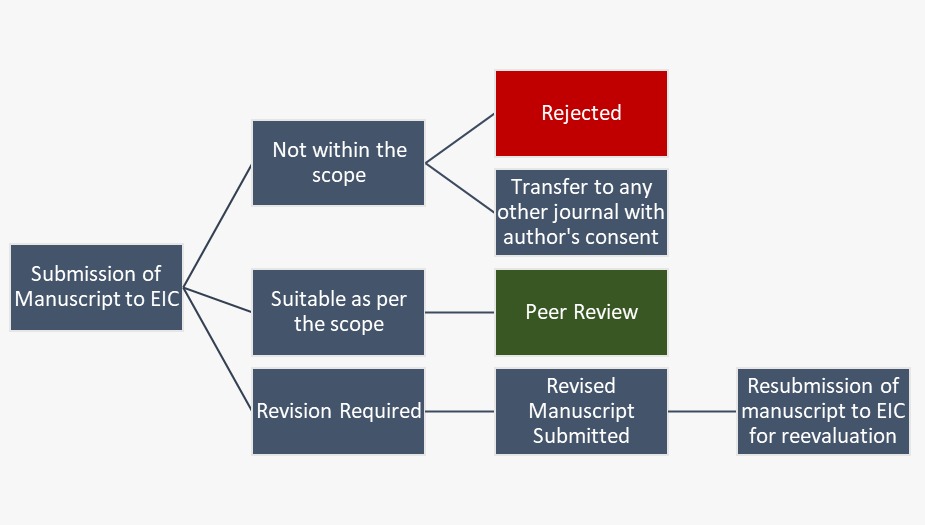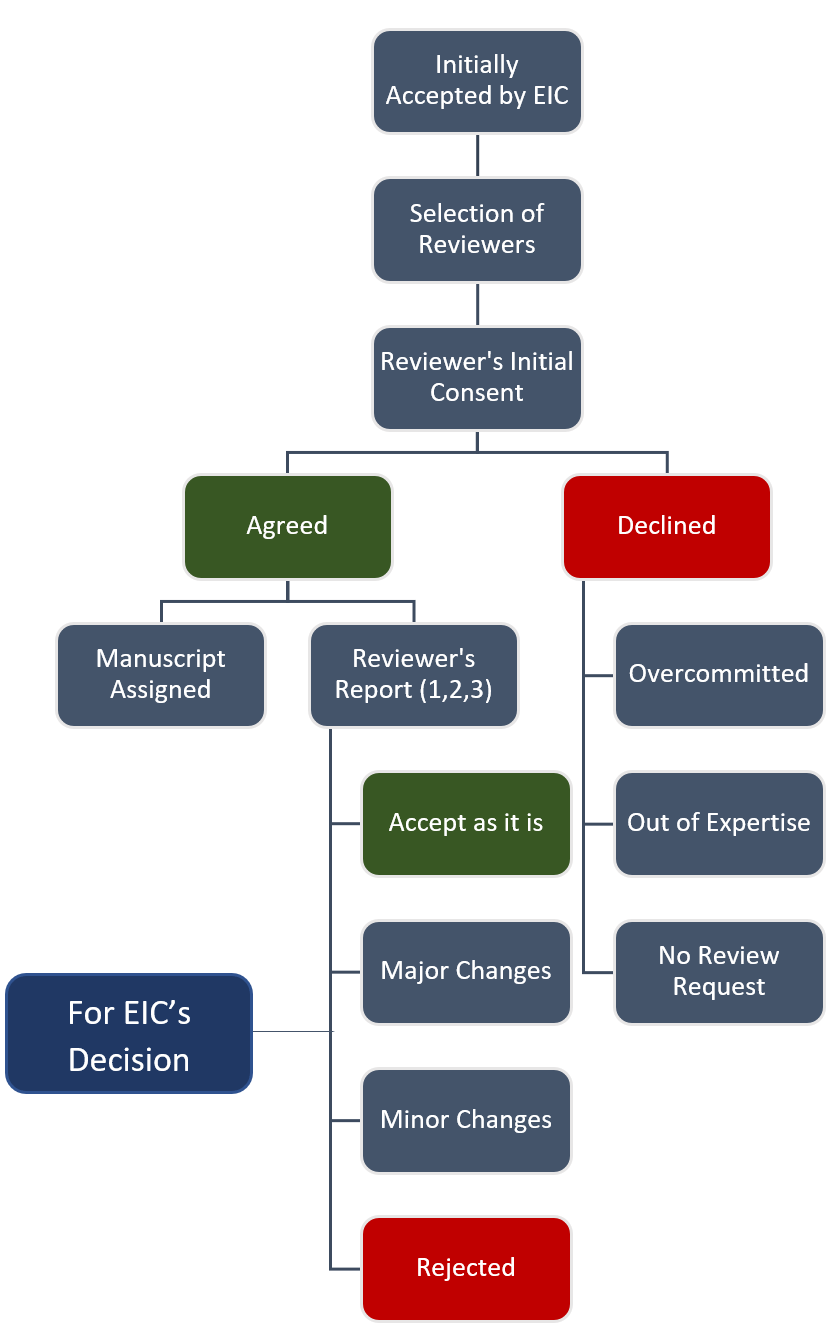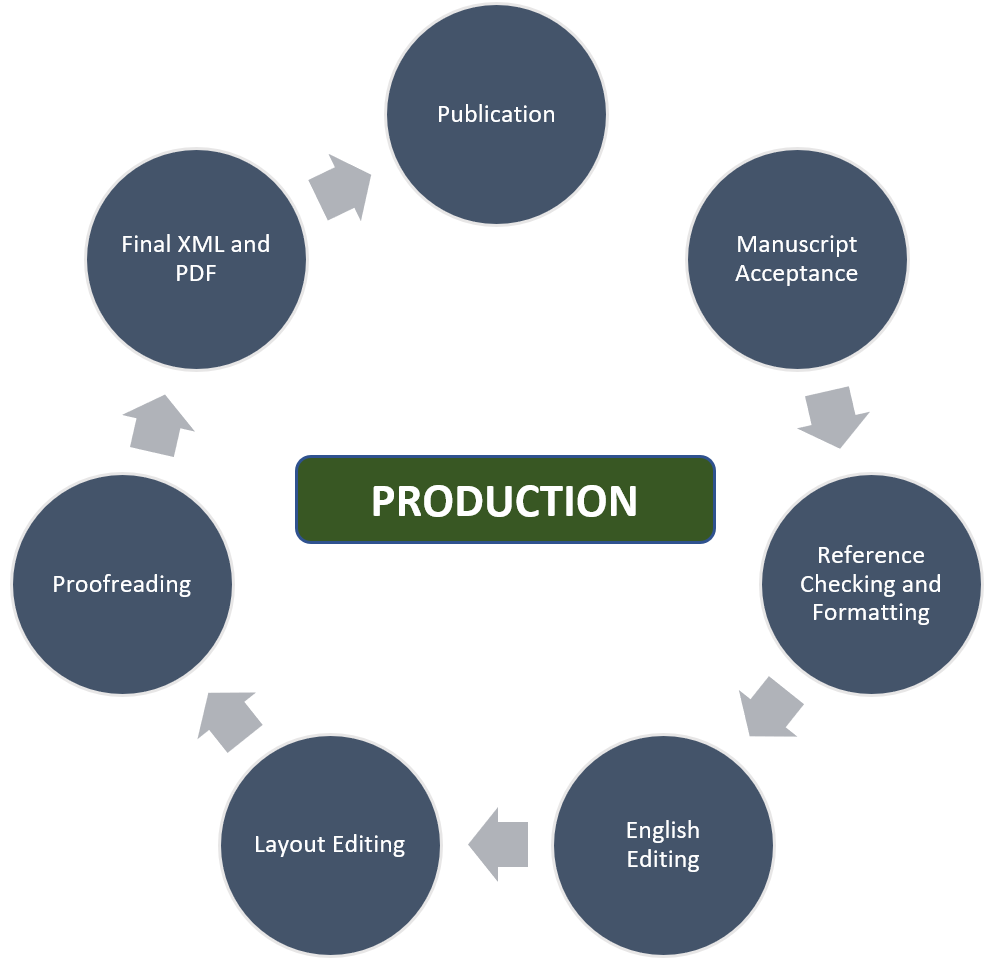Editorial Process
After manuscript submission, the editorial process is followed as below:
I. Initial Check
The initial check consists of three stages:
- Editorial office reviews for guideline adherence,
- Content similarity and author verification, and
- Manuscript scope assessment by the Editor-in-Chief.
Technical Check
After manuscript submission, an initial review is conducted to ensure compliance with guidelines related to conflicts of interest, reporting standards, acknowledgements, authors' complete details, etc. If any section of the manuscript is inadequately described, the author will be asked for revisions.
Content Assessment
 Plagiarism Check
Plagiarism Check
After passing the initial technical check, the manuscript undergoes plagiarism detection using the Crossref plagiarism detection tool, along with author verification.
Author's Verification
To ensure author authenticity, we verify authors' credentials, previous publication records, and digital identifiers. We also confirm institutional email addresses. During manuscript submission, we send acknowledgements to all co-authors' email addresses, and any returned emails raise concerns about the accuracy of the provided email addresses, leading to further investigation.
II. Peer Review
Following the initial decision by the Editor-in-Chief, manuscripts are proceeded further to the peer review process. After consultation with the Editor-in-Chiefs, manuscripts are assigned to relevant members of the Editorial Board members as well as other Scientists working in the field relevant to the manuscript. At Scifinit, we prioritize transparency and rigor, and as such, we take every precaution to ensure there are no conflicts of interest between reviewers and authors. In the rare instance of a conflict, the reviewer is replaced for that specific manuscript. After receiving two or, in some cases, three review reports, the manuscript is sent to the Editor-in-Chief for a decision based on the reviews.
For a detailed understanding of our peer review workflow and procedures, please explore our dedicated Peer Review Workflow page.

III. Editor-in-Chief Decision and Revision
The Editor-in-Chief reviews the reviewers' reports and decides regarding manuscript acceptance, rejection, or revision. The decision is communicated to the author. In the case of a revision, the author is required to submit the revised version along with a response letter within 7 days. If needed, the author may request an extension. The revised manuscript is then resubmitted to the Editor-in-Chief for a decision, which can include sending it back to the author for further revisions, re-review by the same reviewers, or acceptance.
While the Editor-in-Chief may disagree with the reviewers' recommendations, they are expected to provide a valid reason for their decision, which benefits both authors and reviewers. The ultimate responsibility for deciding on manuscript acceptance, revision, or rejection lies with the Editor-in-Chief, and the editorial staff does not interfere in such matters.
If reviewers do not respond to the revised version and the manuscript is delayed, another Editorial Board member or a reviewer working in a similar field may be assigned to conduct the re-review process. During the re-review, the revised manuscript and the authors' responses to the reviewers' comments are sent to the reviewers. A manuscript undergoes revision twice, and if it still lacks significant revisions as requested by the reviewers, it is rejected. If the estimated revision time exceeds 2 months, we suggest that authors consider withdrawing their manuscript and submitting it again as a new manuscript.

Before submitting a manuscript for revision, we conduct a comprehensive review to ensure that the manuscript adheres to international standards and journal guidelines. We also assess the quality of graphics, and if low quality is identified, we communicate with the authors to enhance the quality of their figures. High-quality figures are a mandatory requirement for manuscript publication. However, we do not halt the initial processing, including the peer review, at the beginning. Nevertheless, no manuscript proceeds to production if it does not meet our requirements. This proactive approach allows authors to address all identified issues thoroughly while revising the manuscript in response to the reviewers' comments, resulting in a polished final submission which enhances its chances of acceptance.
Author Appeals
Authors have the option to appeal a rejection by sending an email to the journal's Editorial Office. In order to initiate an appeal, it is essential that the authors provide a comprehensive justification, including a detailed response to the reviewers' and/or Editor's comments, addressing their concerns point by point. It's important to note that appeals can only be submitted following an initial "rejection" decision and should be sent within three months from the date of the initial decision. An appeal will not be considered further if any of the mentioned criteria is not fulfilled.
Appeals should be supported by sound reasoning and substantial evidence that counteracts the criticisms outlined in the rejection letter. It's important to understand that a difference of opinion concerning the manuscript's interest, novelty, or suitability for the journal will not be regarded as a valid basis for appeal.
Upon receiving an appeal, the managing editor will forward it further to the Editor-in-Chief for consideration along with the author’s response, reviewers’ comments and other evidence provided by the authors. Their recommendation may include acceptance, further peer review, or confirmation of the original rejection decision. This recommendation will subsequently be validated by the Editor-in-Chief. It's important to note that a rejection decision at this stage is final and cannot be reversed.
IV. Production
After acceptance, each manuscript receives a unique identifier (DOI), and then it proceeds to the production stage, which includes language checking, typesetting, proofreading, figure and table preparation, citation and reference verification, etc.

Reference Checking and Formatting
After manuscript acceptance, the Editorial office conducts a comprehensive check of references. This involves:
- Duplicate References: Ensuring that references are not cited more than once in the reference section, preventing duplication.
- Authors' Self-Citation Rate: Rechecking the self-citation rate by the authors to maintain academic integrity.
- Reference Formatting: Verifying reference formatting. If major formatting errors are found, authors are requested to provide corrected versions.
- Relevance of Cited References: Adhering to international standards, Scifiniti ensures that articles citing references are relevant. This includes checking for self-citations at the journal or publisher level.
Minor corrections are handled by the Editorial office, and authors are contacted for their approval before proceeding to the next stage. However, in the case of major errors, authors are asked to provide corrected versions of references.
English Editing
Scifiniti requires that all submitted manuscripts meet high English language standards. We strongly recommend that you have the manuscript reviewed by a native English language expert or use professional language editing services to correct any grammatical, scientific, and typographical errors before submitting the manuscript for publication. Scifiniti also offers professional language editing services at discounted rates for authors. Please contact us for a quote and additional details.
Layout Editing
After passing through the language editing stage, the manuscript proceeds to Layout Editing, which involves formatting the manuscript according to the guidelines. This includes setting fonts, margins, headers, footers, formatting figures and tables, and ensuring that the document adheres to the journal template for visual consistency. The final PDF is then sent to the authors for their review to identify any errors that may have occurred during the conversion from a Word file to a PDF.
Proofreading
This is the final stage where the manuscript undergoes a thorough check for any errors. Any corrections pointed out by the authors after layout editing are also reviewed, and the authors are provided with another version of the corrected manuscript for their final approval. Our experienced proofreaders ensure that the final version is now free of errors. They however don’t make any extensive changes in the content or style. This is the last quality check before publication to identify any small errors that might have been missed during previous editing stages.